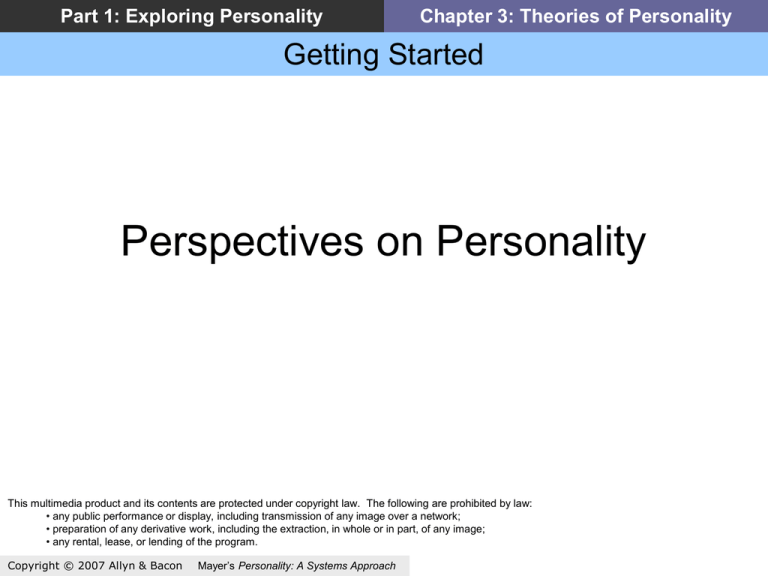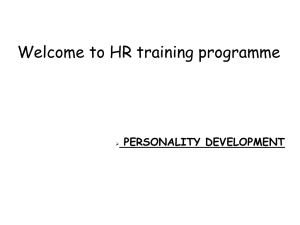ppt - Personality: A Systems Approach
advertisement

Part 1: Exploring Personality Chapter 3: Theories of Personality Getting Started Perspectives on Personality This multimedia product and its contents are protected under copyright law. The following are prohibited by law: • any public performance or display, including transmission of any image over a network; • preparation of any derivative work, including the extraction, in whole or in part, of any image; • any rental, lease, or lending of the program. Copyright © 2007 Allyn & Bacon Mayer’s Personality: A Systems Approach Part 1: Exploring Personality Chapter 3: Theories of Personality Getting Started Topics Covered • • • • • What are Perspectives on Personality? What is the Biopsychological perspective? What is the Intrapsychic perspective? What is the Sociocultural perspective? What is the Temporal-Developmental perspective? • How does one cope with multiple perspectives? Copyright © 2007 Allyn & Bacon Mayer’s Personality: A Systems Approach Part 1: Exploring Personality Chapter 3: Theories of Personality What Are Theoretical Perspectives? Three Levels of Psychological Theory • Personality Perspectives – Reflect broad areas of interest such as: – biological underpinnings – psychological processes • Personality Theories – Sets of related assumptions about personality. (Possibly) familiar examples: – Psychodynamic – Humanistic • Micro-Theories – Specific sets of testable hypotheses – People repress uncomfortable memories – People’s motives direct them in different ways • All Theoretical Levels are Informed by Empirical Findings © Copyright 2006 Allyn & Bacon Mayer’s Personality: A Systems Approach Part 1: Exploring Personality Chapter 3: Theories of Personality What Are Theoretical Perspectives? Major Perspectives Concepts of Personality Biological © Copyright 2006 Allyn & Bacon IntraPsychic Mayer’s Personality: A Systems Approach Social Developmental Part 1: Exploring Personality Chapter 3: Theories of Personality What Are Theoretical Perspectives? Major Perspectives and Theories Concepts of Personality Biological PsychoEvolutionary BioSocial © Copyright 2006 Allyn & Bacon IntraPsychic PsychoDynamic Developmental Social Trait Mayer’s Personality: A Systems Approach SocialCognitive CrossCultural PsychoSocial HumanisticPositive Part 1: Exploring Personality Chapter 3: Theories of Personality What Are Theoretical Perspectives? Why Study Theoretical Perspectives? • They collect together theoretical issues concerning personality that have emerged throughout history • Understanding them provides a context for what you will encounter. • Personality psychologists are informed by them © Copyright 2006 Allyn & Bacon Mayer’s Personality: A Systems Approach Part 1: Exploring Personality Chapter 3: Theories of Personality The Biological Perspective Overview of Biopsychology • Concerns biological explanations and substrates for psychological phenomena • Major Theories: – Psychoevolutionary – Biopsychological © Copyright 2006 Allyn & Bacon Mayer’s Personality: A Systems Approach Part 1: Exploring Personality Chapter 3: Theories of Personality The Biological Perspective Central Ideas of Evolutionary Theory • Organisms with certain features are better able to adapt to hostile forces of nature • Behaviorally, we all face certain questions: Who is my ally? My foe? What food should I eat? Who should I marry? • Individuals who answer those questions better than others are better adapted. • Because they better adapt, they are better able to survive and reproduce • Their genes in the gene pool that control behavioral differences © Copyright 2006 Allyn & Bacon Mayer’s Personality: A Systems Approach Part 1: Exploring Personality Chapter 3: Theories of Personality The Biological Perspective An Example • Giraffes once had shorter necks • Giraffes with taller necks better found food (highgrowing leaves) • They are therefore more likely to reproduce © Copyright 2006 Allyn & Bacon Mayer’s Personality: A Systems Approach Part 1: Exploring Personality Chapter 3: Theories of Personality The Biological Perspective Second Example • There was selection for larger brains • This led to greater capacity to amass resources • Greater reproductive success • Pre Homo Sapien Examples: – Austrolopithecus Afarensis – Australopithecus Africanus © Copyright 2006 Allyn & Bacon Mayer’s Personality: A Systems Approach Part 1: Exploring Personality Chapter 3: Theories of Personality The Biological Perspective Central Ideas of Biopsychology • Genetics Influence the Brain • The Brain Influences Behavior Through: – – – – Brain Structure Neurotransmitters Hormones Immune Function © Copyright 2006 Allyn & Bacon Mayer’s Personality: A Systems Approach Part 1: Exploring Personality Chapter 3: Theories of Personality The Biological Perspective Genetic Influences as Viewed through Twin Studies • Monozygotic twins….100% genetic material in common • Dizygotic twins…50% genetic material in common • Cousins, aunts, uncles…25% • Strangers…0% © Copyright 2006 Allyn & Bacon Mayer’s Personality: A Systems Approach Part 1: Exploring Personality Chapter 3: Theories of Personality The Biological Perspective Correlations Between Pairs of Individuals for Four Personality Traits Trait Mono. Twins reared together Mono.. Twins reared apart Sibs. Reared together Sibs. Reared apart Intell. .86 .72 .47 .24 Extrav. .54 .30 .06 .04 Neurot. .41 .25 .24 .28 Open. .51 .43 .14 .23 © Copyright 2006 Allyn & Bacon Mayer’s Personality: A Systems Approach Part 1: Exploring Personality Chapter 3: Theories of Personality The Biological Perspective Corpus Collusum: Relevant to Personality? Corpus Collusum • (Brain structure): The corpus callosum permits communication between the two hemispheres • When it is larger, it better permits a person to integrate emotion and thought • It is larger (on average) in women. • Women are better able to integrate some emotional information © Copyright 2006 Allyn & Bacon Mayer’s Personality: A Systems Approach Part 1: Exploring Personality Chapter 3: Theories of Personality The Intrapsychic Perspective Central Ideas of the Trait Approach • There are consistencies in personal behavior • These consistencies are important parts of personality called traits • Personality is the search for and understanding of traits • Key figure: Gordon Allport © Copyright 2006 Allyn & Bacon Mayer’s Personality: A Systems Approach Part 1: Exploring Personality Chapter 3: Theories of Personality The Intrapsychic Perspective Openness Example: The Big Five Traits Agreeableness Conscientiousness © Copyright 2006 Allyn & Bacon Extraversion Mayer’s Personality: A Systems Approach Neuroticism Part 1: Exploring Personality Chapter 3: Theories of Personality The Intrapsychic Perspective Traits Can Be Identified Through Factor Analysis Items (Are you…?) I II III IV V Anxious .50 .20 .02 .14 .10 Distressed .60 .10 .02 .10 -.13 Calm -.45 .02 -.04 -.10 -.05 Open-minded .02 .70 .10 -.10 -.07 Strait and narrow .10 -.60 .10 -.10 -.10 Warm-hearted -.10 .04 .80 -.12 .00 Stand-offish .20 .00 -.70 .15 .12 Orderly .12 -.14 .03 .87 .00 Spontaneous .13 -12 .21 -.60 .60 Outgoing -.12 .10 .30 .12 .80 Enjoy solitude .12 .20 -.35 -.05 -.70 Hostile .35 .07 -.50 .15 .05 © Copyright 2006 Allyn & Bacon Mayer’s Personality: A Systems Approach Part 1: Exploring Personality Chapter 3: Theories of Personality The Intrapsychic Perspective Central Psychodynamic Ideas • Central idea(s): – Parts of personality • Conscious • Unconscious – Parts dynamically struggle with one another – Dynamics can be changed for the better © Copyright 2006 Allyn & Bacon Conscious Mayer’s Personality: A Systems Approach Unconscious Threatening ideas are avoided and become unconscious Part 1: Exploring Personality Chapter 3: Theories of Personality The Intrapsychic Perspective Psychodynamic Perspective: Example • Example: • …The person free associates until unconscious desires are uncovered… • The person will be mentally healthier by making the unconscious conscious © Copyright 2006 Allyn & Bacon Mayer’s Personality: A Systems Approach Part 1: Exploring Personality Chapter 3: Theories of Personality The Sociocultural Approach Perspective Central Social-Cognitive Ideas • Personality is made up of cognitive structures • Those cognitive structures are learned and influence how a person thinks © Copyright 2006 Allyn & Bacon Mayer’s Personality: A Systems Approach Part 1: Exploring Personality Chapter 3: Theories of Personality The Sociocultural Approach Perspective Social Cognitive Approach Conditional Aggression in Children Level of Aggression • Conditional Traits • Given X, I am aggressive • Given Y, I am cooperative 35 30 25 20 15 10 5 0 Child 1 Child 2 Adult Peers Presence of Adult © Copyright 2006 Allyn & Bacon Mayer’s Personality: A Systems Approach Part 1: Exploring Personality Chapter 3: Theories of Personality The Sociocultural Approach Perspective Ideas of the Cultural Perspective • Personality involves learned understanding of the world and attitudes toward it. • Cultures convey such information • Some personality aspects are general over cultures • Others differ over cultures © Copyright 2006 Allyn & Bacon Mayer’s Personality: A Systems Approach Part 1: Exploring Personality Chapter 3: Theories of Personality The Sociocultural Approach Perspective Ideas of the Cultural Perspectives Autonomy vs. Communal orientation © Copyright 2006 Allyn & Bacon Mayer’s Personality: A Systems Approach Part 1: Exploring Personality Chapter 3: Theories of Personality The Temporal-Developmental Approach Psycho-Social Stage Theories • Idea that children and adults’ personality develop according to understandable patterns such as life stages. • Each stage or pattern involves the achievement of certain goals • Erik Erikson, for example, described eight stages of growth. © Copyright 2006 Allyn & Bacon Mayer’s Personality: A Systems Approach Part 1: Exploring Personality Chapter 3: Theories of Personality The Temporal-Developmental Approach Humanistic Theory: Central Ideas • The person is motivated to grow in a healthy fashion • The person develops toward selfactualization • Key figures: Carl Rogers, Abraham Maslow © Copyright 2006 Allyn & Bacon Mayer’s Personality: A Systems Approach SelfActualization Esteem Needs Belonging Needs Safety Needs Physiological Needs Part 1: Exploring Personality Chapter 3: Theories of Personality The Temporal-Developmental Approach Humanistic Perspective • Example: …A person given a warm, unconditionally accepting environment, will learn about their real needs and achieve mental health © Copyright 2006 Allyn & Bacon Mayer’s Personality: A Systems Approach Part 1: Exploring Personality Chapter 3: Theories of Personality Using the Approaches Together How can Perspectives be Integrated? • Is one theory correct? – Comparative analyses are challenging – No one seems to stand out • Should you commit to one? – The language of a theory can put up artificial barriers – Commitment to one is limiting © Copyright 2006 Allyn & Bacon Mayer’s Personality: A Systems Approach Part 1: Exploring Personality Chapter 3: Theories of Personality Using the Approaches Together The Systems Approach Here • The different perspectives can be translated into a common language. – Freud’s introject (an internalized image of another) can be translated into cognitive psychology’s mental model – Roger’s real self can be translated into general terminology of emotions and the selfconcept. © Copyright 2006 Allyn & Bacon Mayer’s Personality: A Systems Approach Part 1: Exploring Personality Chapter 3: Theories of Personality Using the Approaches Together The Systems Approach Here • The different perspectives share concerns that can be described by some basic topics: – What is personality? – What are its parts? – What is its organization? – How does it develop? • Theories are then drawn upon to answer questions about these topics, as needed. © Copyright 2006 Allyn & Bacon Mayer’s Personality: A Systems Approach Part 1: Exploring Personality Chapter 3: Theories of Personality Getting Started ~end of Chapter 3~ Copyright © 2007 Allyn & Bacon Mayer’s Personality: A Systems Approach









